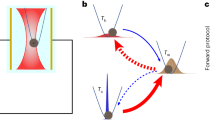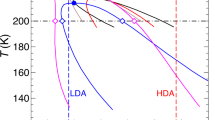Abstract
As the temperature of a cooling object decreases as it relaxes to thermal equilibrium, it is intuitively assumed that a hot object should take longer to cool than a warm one. Yet, some 2,300 years ago, Aristotle observed that “to cool hot water quickly, begin by putting it in the sun”1,2. In the 1960s, this counterintuitive phenomenon was rediscovered as the statement that “hot water can freeze faster than cold water” and has become known as the Mpemba effect3; it has since been the subject of much experimental investigation4,5,6,7,8 and some controversy8,9. Although many specific mechanisms have been proposed6,7,10,11,12,13,14,15,16, no general consensus exists as to the underlying cause. Here we demonstrate the Mpemba effect in a controlled setting—the thermal quench of a colloidal system immersed in water, which serves as a heat bath. Our results are reproducible and agree quantitatively with calculations based on a recently proposed theoretical framework17. By carefully choosing parameters, we observe cooling that is exponentially faster than that observed using typical parameters, in accord with the recently predicted strong Mpemba effect18. Our experiments outline the generic conditions needed to accelerate heat removal and relaxation to thermal equilibrium and support the idea that the Mpemba effect is not simply a scientific curiosity concerning how water freezes into ice—one of the many anomalous features of water19—but rather the prototype for a wide range of anomalous relaxation phenomena of broad technological importance.
This is a preview of subscription content, access via your institution
Access options
Access Nature and 54 other Nature Portfolio journals
Get Nature+, our best-value online-access subscription
$29.99 / 30 days
cancel any time
Subscribe to this journal
Receive 51 print issues and online access
$199.00 per year
only $3.90 per issue
Buy this article
- Purchase on Springer Link
- Instant access to full article PDF
Prices may be subject to local taxes which are calculated during checkout





Similar content being viewed by others
Data availability
The datasets generated and analysed during this study are available at https://doi.org/10.6084/m9.figshare.12203021.v1. Source data are provided with this paper.
Code availability
The analysis codes that support the findings of this study are available at https://doi.org/10.6084/m9.figshare.12203030.v1.
References
Aristotle Meterologica Book 1, Part 12 (transl. Webster, E. W.) (Clarendon Press, 1923).
Jeng, M. The Mpemba effect: when can hot water freeze faster than cold? Am. J. Phys. 74, 514–522 (2006).
Mpemba, E. B. & Osborne, D. G. Cool? Phys. Educ. 4, 172–175 (1969).
Wojciechowski, B., Owczarek, I. & Bednarz, G. Freezing of aqueous solutions containing gases. Cryst. Res. Technol. 23, 843–848 (1988).
Auerbach, D. Supercooling and the Mpemba effect: when hot water freezes quicker than cold. Am. J. Phys. 63, 882–885 (1995).
Vynnycky, M. & Maeno, N. Axisymmetric natural convection-driven evaporation of hot water and the Mpemba effect. Int. J. Heat Mass Transf. 55, 7297–7311 (2012).
Vynnycky, M. & Kimura, S. Can natural convection alone explain the Mpemba effect? Int. J. Heat Mass Transfer 80, 243–255 (2015).
Burridge, H. C. & Linden, P. F. Questioning the Mpemba effect: hot water does not cool more quickly than cold. Sci. Rep. 6, 37665 (2016).
Katz, J. I. Reply to Burridge & Linden: Hot water may freeze sooner than cold. Preprint at https://arxiv.org/abs/1701.03219 (2017).
Mirabedin, S. M. & Farhadi, F. Numerical investigation of solidification of single droplets with and without evaporation mechanism. Int. J. Refrig. 73, 219–225 (2017).
Vynnycky, M. & Mitchell, S. Evaporative cooling and the Mpemba effect. Heat Mass Transf. 46, 881–890 (2010).
Katz, J. I. When hot water freezes before cold. Am. J. Phys. 77, 27–29 (2009).
Esposito, S., De Risi, R. & Somma, L. Mpemba effect and phase transitions in the adiabatic cooling of water before freezing. Physica A 387, 757–763 (2008).
Zhang, X. et al. Hydrogen-bond memory and water-skin supersolidity resolving the Mpemba paradox. Phys. Chem. Chem. Phys. 16, 22995–23002 (2014).
Jin, J. & Goddard, W. A., III Mechanisms underlying the Mpemba effect in water from molecular dynamics simulations. J. Phys. Chem. C 119, 2622–2629 (2015).
Tao, Y., Zou, W., Jia, J., Li, W. & Cremer, D. Different ways of hydrogen bonding in water—why does warm water freeze faster than cold water? J. Chem. Theory Comput. 13, 55–76 (2017).
Lu, Z. & Raz, O. Nonequilibrium thermodynamics of the Markovian Mpemba effect and its inverse. Proc. Natl Acad. Sci. USA 114, 5083–5088 (2017).
Klich, I., Raz, O., Hirschberg, O. & Vucelja, M. Mpemba index and anomalous relaxation. Phys. Rev. X 9, 021060 (2019).
Sun, C. Q. & Sun, Y. The Attribute of Water: Single Notion, Multiple Myths (Springer, 2016).
Chaddah, P., Dash, S., Kumar, K. & Banerjee, A. Overtaking while approaching equilibrium. Preprint at https://arxiv.org/abs/1011.3598 (2010).
Ahn, Y.-H., Kang, H., Koh, D.-Y. & Lee, H. Experimental verifications of Mpemba-like behaviors of clathrate hydrates. Korean J. Chem. Eng. 33, 1903–1907 (2016).
Hu, C. et al. Conformation directed Mpemba effect on polylactide crystallization. Cryst. Growth Des. 18, 5757–5762 (2018).
Lasanta, A., Reyes, F. V., Prados, A. & Santos, A. When the hotter cools more quickly: Mpemba effect in granular fluids. Phys. Rev. Lett. 119, 148001 (2017).
Torrente, A. et al. Large Mpemba-like effect in a gas of inelastic rough hard spheres. Phys. Rev. E 99, 060901 (2019).
Baity-Jesi, M. et al. The Mpemba effect in spin glasses is a persistent memory effect. Proc. Natl Acad. Sci. USA 116, 15350–15355 (2019).
Greaney, P. A., Lani, G., Cicero, G. & Grossman, J. C. Mpemba-like behavior in carbon nanotube resonators. Metall. Mater. Trans. A 42, 3907–3912 (2011).
Nava, A. & Fabrizio, M. Lindblad dissipative dynamics in the presence of phase coexistence. Phys. Rev. B 100, 125102 (2019).
Keller, T. et al. Quenches across the self-organization transition in multimode cavities. New J. Phys. 20, 025004 (2018).
Gijón, A., Lasanta, A. & Herna’ndez, E. Paths towards equilibrium in molecular systems: the case of water. Phys. Rev. E 100, 032103 (2019).
Zhang, L. Cooling Dynamics of a Brownian Particle and the Markovian Mpemba Effect. MSc thesis, Simon Fraser Univ. (2019).
Lebowitz, J. L. & Bergmann, P. G. Irreversible Gibbsian ensembles. Ann. Phys. 1, 1–23 (1957).
Risken, H. The Fokker-Planck Equation: Methods of Solution and Applications 2nd edn (Springer, 1989).
Goldenfeld, N. Lectures on Phase Transitions and the Renormalization Group (Addison-Wesley, 1992).
Debenedetti, P. G. Metastable Liquids: Concepts and Principles (Princeton Univ. Press, 1997).
Gal, A. & Raz, O. Precooling strategy allows exponentially faster heating. Phys. Rev. Lett. 124, 060602 (2020).
Moore, A. L. & Shi, L. Emerging challenges and materials for thermal management of electronics. Mater. Today 17, 163–174 (2014).
Kumar, A. & Bechhoefer, J. Optical feedback tweezers. Proc. SPIE 10723, 107232J (2018).
Cohen, A. E. Control of nanoparticles with arbitrary two-dimensional force fields. Phys. Rev. Lett. 94, 118102 (2005).
Jun, Y. & Bechhoefer, J. Virtual potentials for feedback traps. Phys. Rev. E 86, 061106 (2012).
Chupeau, M., Gladrow, J., Chepelianskii, A., Keyser, U. F. & Trizac, E. Optimizing Brownian escape rates by potential shaping. Proc. Natl Acad. Sci. USA 117, 1383–1388 (2020).
Bérut, A. et al. Experimental verification of Landauer’s principle linking information and thermodynamics. Nature 483, 187–189 (2012).
Kumar, A. & Bechhoefer, J. Nanoscale virtual potentials using optical tweezers. Appl. Phys. Lett. 113, 183702 (2018).
Press, W. H., Plannery, B. P., Teukolsky, S. A. & Vetterling, W. T. Numerical Recipes: The Art of Scientific Computing 3rd edn (Cambridge Univ. Press, 2007).
Jaynes, E. T. Probability Theory: The Logic of Science (Cambridge Univ. Press, 2003).
Stone, M. & Goldbart, P. Mathematics for Physics: A Guided Tour for Graduate Students (Cambridge Univ. Press, 2009).
Acknowledgements
We thank O. Raz, Z. Lu, K. Proesmans, R. Chétrite, N. Forde, S. Dodge and T. K. Saha for suggestions; X. Su and especially L. Zhang, who contributed to preliminary versions of the experiment. This research work has been supported by Discovery and RTI Grants from the National Sciences and Engineering Research Council of Canada (NSERC).
Author information
Authors and Affiliations
Contributions
J.B. conceived and designed the research; A.K. built the optical tweezers setup and performed the experiment; J.B. and A.K analysed the data and wrote the paper.
Corresponding author
Ethics declarations
Competing interests
The authors declare no competing interests.
Additional information
Peer review information Peer reviewer reports are available.
Publisher’s note Springer Nature remains neutral with regard to jurisdictional claims in published maps and institutional affiliations.
Extended data figures and tables
Extended Data Fig. 1 One cycle of a feedback trap.
a, Measure the particle position. b, Calculate force from the gradient of the imposed potential (black) based on the position. c, Apply the force by shifting the harmonic trap centre (blue). The force applied is a linear restoring force with k the stiffness of the harmonic trap and Δx the imposed trap displacement.
Extended Data Fig. 2 Schematic of the feedback-trap setup.
AOD, acousto-optic deflector; BS, beam splitter (non-polarizing); Cam, camera; DM, dichroic mirror; F, short-pass filter; FI, Faraday isolator; HW, half-wave plate; L, lens; LED, light-emitting diode; M, mirror; MO, microscope objective; PBS, polarizing beam splitter; PD, photodiode; QPD, quadrant photodiode; SC, sample chamber; SF, spatial filter; FPGA, field-programmable gate array. Planes that are conjugate to the backfocal plane of the trapping objective are shown in red dashed lines.
Extended Data Fig. 3 Schematic of potential energy landscape.
The bath potential energy is shown with different slopes for the kinetic path. A steep slope represents high velocities with which the particles are quenched towards the minima. The steepness of the linear potential determines both the time and temperature scales.
Extended Data Fig. 4 Empirical potential energy landscape.
Red markers denote the potential reconstructed from the Boltzmann distribution of the position measurements, with no curve fitting; the superimposed solid blue line shows the imposed potentials. The error bars represent \(\sqrt{{N}_{{\rm{b}}}}/N\), where Nb is the number of counts in each bin and N the total number of counts.
Extended Data Fig. 5 Finite maximum slope of the potential does not affect particle dynamics substantially.
a, The energy landscape for the Mpemba effect. Solid line depicts the initial energy landscape with infinite potential walls at the domain boundaries. The equilibrium distribution of the particle is calculated based on this potential (Uinitial). Dashed line shows the potential (Uquenched) in which the particle is quenched. b, Langevin simulations of the Mpemba effect using both potentials show no notable differences between the two cases.
Extended Data Fig. 6 Cumulative probability distribution at the bath temperature.
The cumulative distribution of the Boltzmann distribution (inset) at the bath temperature is calculated. An algorithm based on binary search and linear interpolation is used to map the CDF (F) to position x (dashed lines). Asymmetry coefficient, α = 9.
Extended Data Fig. 7 Mpemba effect is robust to the choice of distance measure.
a, b, The L1 (a) and KL distances (b). Data correspond to Fig. 2 for hot (Th = 1,000), warm (Tw = 12) and cold (Tc = 1) temperatures. Both distance measures show crossing, indicating the Mpemba effect.
Extended Data Fig. 8 Eigenfunctions of the FP operator.
u2(x) and v2(x) are the left and right eigenfunctions, respectively, and correspond to the smallest non-zero eigenvalue of the FP operator. The negative of the left eigenfunction is plotted to aid to better visualization. The eigenfunctions are calculated for α = 3.
Extended Data Fig. 9 Different noise levels do not affect the difference in equilibration time.
The hot (red) and warm (blue) systems have the same slope at large times (set by the potential energy). The signal decreases until it hits one of two different noise levels, n1 or n2 (indicated by thick red lines and horizontal dashes). The difference in the equilibration time is independent of the noise levels: Δt1 = Δt2 = tw − th.
Supplementary information
Rights and permissions
About this article
Cite this article
Kumar, A., Bechhoefer, J. Exponentially faster cooling in a colloidal system. Nature 584, 64–68 (2020). https://doi.org/10.1038/s41586-020-2560-x
Received:
Accepted:
Published:
Issue Date:
DOI: https://doi.org/10.1038/s41586-020-2560-x
Comments
By submitting a comment you agree to abide by our Terms and Community Guidelines. If you find something abusive or that does not comply with our terms or guidelines please flag it as inappropriate.



